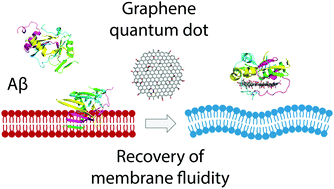Graphene quantum dots obstruct the membrane axis of Alzheimer's amyloid beta†
Abstract
Alzheimer's disease (AD) is a primary form of dementia with debilitating consequences, but no effective cure is available. While the pathophysiology of AD remains multifactorial, the aggregation of amyloid beta (Aβ) mediated by the cell membrane is known to be the cause for the neurodegeneration associated with AD. Here we examined the effects of graphene quantum dots (GQDs) on the obstruction of the membrane axis of Aβ in its three representative forms of monomers (Aβ-m), oligomers (Aβ-o), and amyloid fibrils (Aβ-f). Specifically, we determined the membrane fluidity of neuroblastoma SH-SY5Y cells perturbed by the Aβ species, especially by the most toxic Aβ-o, and demonstrated their recovery by GQDs using confocal fluorescence microscopy. Our computational data through discrete molecular dynamics simulations further revealed energetically favorable association of the Aβ species with the GQDs in overcoming peptide–peptide aggregation. Overall, this study positively implicated GQDs as an effective agent in breaking down the membrane axis of Aβ, thereby circumventing adverse downstream events and offering a potential therapeutic solution for AD.

- This article is part of the themed collection: 2021 PCCP HOT Articles


 Please wait while we load your content...
Please wait while we load your content...